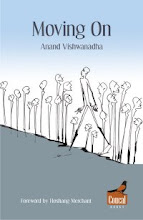I still remember my first ride to Vizag as if it was yesterday. The usual confusion of last minute packing and unpacking with Kishore at my place to oversee it all, the long wait for it to stop raining, the early morning departure at 2.30 and then the ride through puddles of water till I was on the chaotic Vijayawada highway -in the face of every Trucker and Buswallah hurrying inbound to the charms of Biryani land.
This really manic ride had happened sometime in July 2002. Once on the highway, I conveniently forgot where I was headed and went boating in a Shrimp pond and thereafter dozed off besides a canal for three odd hours. Evening found me on the road again and I had a run in with some louts (15 odd in number and me alone) who chased me for 40 or so kilometres on the highway after Rajahmundry. Then I lost my way, was helped by a trucker who asked me to tail him and finally decided to sleep at some non-descript place called Jaggayapetta. This blessed sanctuary on a dark, still being built highway (I think this was also the first ride when I discovered what it means to have a "black and blue" butt) of course had only one lodge where everyone down from the owner to the watchman were displaying full-blown gay tendencies. To cut the story short, I reached Vizag sometime at 11.00 in the afternoon, the day after.
The second time I rode to Vizag, I left sometime in the afternoon, of course it was again summer, I think it was in May 2003. This time, the tentative plan {I am sure you would doubt my vocabulary seeing how I abuse a word as nice as "plan"} was to shack out besides the road at some Dhaba around Vijayawada and then ride out early in the morning. It turned out to be something else altogether, I couldn't find the Dhaba I had earmarked for the stop, decided to sleep besides the highway (near Eluru) and even snored for an hour or so, before the Highway Patrol stopped by and politely asked me to prove to be sane. Finally, I managed to find a Dhaba where they did allow me to sleep, but it was too hot and too mosquito rich a night for me to do any slumbering. To cut this story short, I reached Vizag at around 10.30 in the afternoon, again on the day after.
Just for the record, on the second ride, I had a fairly bodacious moon winking at me for most of the night.
Thus it was, that the stage was set for the grandest and most succulent of my night rides ever. I am of course talking of my third ride to Vizag. The reason for going there was pretty simple, I had to go to Bhubaneswar to attend a marriage and I wasn't getting train tickets. Eashwar (he's from Vizag) promised to get me a ticket from Vizag onwards, so I finally managed to convince my elder brother around 3.00 in the afternoon and then managed to leave Paradise Cross Roads (Ajay came over and gave me his camera, a spare tube and a tool kit) at around 4.30, was on the highway by 5.15 and had an entire night stretching in front of me - with as usual, no fixed plans about where to stop or sleep.
I was riding after a long while, so just being on the highway was a heightened release, so naturally I cut out all the stops and it was around 220 kms by the odo when I stopped somewhere for a Tea break and the obligatory leg stretching session. And that's when Lison sms'ed from Hyderabad asking me if I was game for a Dhaba ride on the Medhchal stretch.
Grin.
It was just 9.15 or so, the ride till now had been just marvelous so I promised Lison that I will keep him in the loop and hit the road again. And then all of a sudden the realization hit me. That, I wasn't out on another small night ride, but that I could ride all the way to Vizag (and probably even beyond). And that there was a full, incandescently brilliant moon up there in the heavens, lighting up my way.
Naturally, I just went moon mad, my body on the bike and on the road, but my being stalking the shadows of the trees and the shrubs and drinking in the glint of the moon off the water bodies, all in passing.
I rode the whole stretch from Vijayawada to Eluru without lights, it was so bright. I even managed to check the level of the petrol in the tank and examine my log (on a scrap of paper) by the moonlight, it was so bright.
Back then, the highway was still being widened 60 odd kms after Eluru and that is when the road deviated away, picking up some more character, when it passes through a lovely maze of small villages, shrimp ponds, canals and rice fields. And all that character was on display with a moon shining down on it! It is moments and hours and experiences like this that get frozen in one's being, out there on the road, especially when the road isn't a highway that's just a straight leting u rippppppp....
And then, it happened, I got four smses one after the other, the culprit being of course the fact that I was suddenly getting a signal, I wonder if all that vibration means a call, stop and pull the mobile out of my pocket and then forget all about the phone, the bike, the ride, every single thing. Because, I had stopped on a slight elevation on the road and all around me was a spectacular panorama that was simply magical. Waters from shrimp ponds, small tanks and the usual skein of canals and rice fields glinting silver in the moonlight, coconut palms so brightly lit that I could really make out the coconuts and behind and above it all, the moon itself, big, bright and bodacious. Fittingly enough, while I lit a smoke in the silent solitude of the night, I could see that very moon framed against gently waving coconut palm leaves, for all purposes, suddenly arboreal, very rooted for me to tarry a bit and enjoy its beauty.
Thereafter, the smoke vanquished, I just had to shake my head and move on again, though all of my being wanted to just ride down to the waters below and park the bike and just rest my back on it, watching the stars and the moonlit heavens.
By this time it was somewhere around 2.00 in the morning again and I was pretty intent on reaching Vizag by dawn, so I belted a bit, slowing down now and then on seeing the moon glinting on canal waters or rice paddies, till I got to Rajamundry.
This is a town that I have never really explored, but getting to Rajamundry has always been synonymous with having the choice of crossing the river Godavari in a different way, every time. The first time I rode on this stretch, I had passed through Rajahmundry town and crossed the Godavari by the heavily used road bridge. The second time, I had used the quaint, more than 100 years old, spectacular Dowleswaram Barrage and on this ride, I was on the rail cum road bridge, arguably, Asia's largest, with the road on top and the rails below. And boy, oh boy, was it fun? Considering that I have crossed the Godavari any number of times on a train of the same name, always at the window or the door, always flipping coins into the deep waters, always wondering what it would be like to float down below, float down to the Bay of Bengal itself.
Once beyond the Godavari and its silvery deeps, I was on the home stretch to Vizag (that's the coast where I was born) and by now the moon was sinking fast, headed for the horizon, almost as if it wanted to sleep. The last 100 kms to Vizag was me fighting sleep and belting on the relatively traffic free roads, and me slowing down wherever the highway was raised, enjoying almost an aerial view of coconut grove after coconut grove down below, interspersed by plaintains and Oil Palms.
Finally, I stopped, just before the turnoff that leads into Vizag through the Steel Plant, blessed by the sight of an amazing dawn that just begged to be photographed. A couple of shutter clicks and a smoke later, I said bye to the highway, entering the byepass that leads to the Steel Plant, riding through its campus to be in Vizag again, to park the bike at my uncle's house at 7.15 in the morning.
Really, whatttttarideeee!



